
Carex nigra is a perennial species of plants in the family Cyperaceae native to wetlands of Europe, western Asia, northwestern Africa, and eastern North America. Common names include common sedge, black sedge or smooth black sedge. The eastern limit of its range reaches central Siberia, Turkey and probably the Caucasus.

Carex vesicaria is an essentially Holarctic species of sedge known as bladder sedge, inflated sedge, and blister sedge. It has been used to insulate footwear in Norway and among the Sami people, and for basketry in North America.

Carex disticha is a Eurasian species of sedge known as the brown sedge or, in North America, tworank sedge.

Carex acutiformis, the lesser pond-sedge, is a species of sedge.

Carex otrubae, the false fox-sedge, is a species of flowering plant in the sedge family, Cyperaceae.
Carex accrescens is a species of sedge that was first described by Jisaburo Ohwi in 1931. It is native to eastern Asia, from Siberia to the Korean Peninsula and Japan.

Carex lanceolata is a species of sedge, native to the eastern half of China, Mongolia, eastern Siberia, Korea, Sakhalin, and Japan. Its seeds are dispersed by ants.
Carex aphyllopus is a species of sedge. Its native range is Central Japan.

Carex flava, called hedgehog grass, is a widespread species of sedge, native to the northern United States, Canada, Iceland, Europe, the Atlas Mountains in Africa, the Transcaucasus area, and parts of Siberia. It is the namesake of the Carex flava species complex.

Carex bohemica is a species of sedge, native to Europe, Siberia, and northern Asia to Japan. It prefers to grow in mud flats.

Carex stipata, variously called the prickly sedge, awl-fruited sedge, awlfruit sedge, owlfruit sedge, swamp sedge, sawbeak sedge, stalk-grain sedge and common fox sedge, is a species of flowering plant in the genus Carex, native to Canada, the United States, China, Korea, Japan, and Far Eastern Russia. It is a wetland obligate.

Carex atrata, called black alpine sedge, is a widespread species of flowering plant in the genus Carex, native to Greenland, Iceland, and most of Europe, plus scattered locations across temperate Asia, including Anatolia, Siberia and the Himalaya, as far as Taiwan and Japan. Its chromosome number is 2n=52, with some variants reported, e.g. n2=54 for Greenland material.

Carex dioica, the dioecious sedge, is a species of flowering plant in the genus Carex, native to Iceland, the Faroes, Svalbard, nearly all of Europe, western Siberia, and the Altai. It prefers to live in calcareous fens.

Carex supina, called the weak arctic sedge, is a species of flowering plant in the genus Carex, native to Alaska, western and central Canada, Minnesota, Greenland, central and eastern Europe, the Caucasus region, Central Asia, Siberia, the Himalaya, the Amur region, Manchuria, and Korea. It is often found in association with Festuca altaica and Poa glauca.

Carex breviculmis, called the Asian shortstem sedge, is a species of flowering plant in the genus Carex, native to Asia from the Indian subcontinent to Southeast Asia, China, Taiwan, Korea, Japan, north as far as Khabarovsk Krai, and Malesia, New Guinea, Australia, Norfolk Island and New Zealand. It has been introduced to the US state of Mississippi. Typically found in forests, it is quite shade tolerant.

Carex muehlenbergii is a species of flowering plant, it is a type of sedge. It is a grass-like plant in the family Cyperaceae. Its common names include sand sedge, Muhlenberg's sedge.

Carex tenuiflora, the sparse-flowered sedge, is a species of flowering plant in the family Cyperaceae. It is native to the Subarctic and Hemiboreal Northern Hemisphere; Alaska, Canada, the northern US, Scandinavia, the Baltic States, all of Russia, the north Caucasus, Siberia, the Russian Far East, Mongolia, northern China, Korea, and Japan. It is most often found in peatlands, preferring a pH of 6.

Carex elongata, the elongated sedge, is a species of flowering plant in the family Cyperaceae, native to Europe, the Caucasus, western Siberia, Kazakhstan, and the Altai. It occurs in boggy woodland and wet meadows, where it forms dense tussocks up to about 1 m tall.
Carex deweyanaDewey's sedge, short-scale sedge, is a species of sedge native to Canada and the United States.

Carex sordida is a species of sedge, native to southern Siberia, Mongolia, Manchuria, the Russian Far East, Korea, and Japan. Its chromosome number is 2n = 100.

















